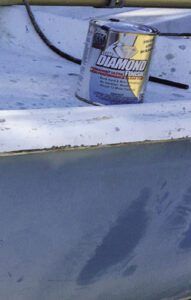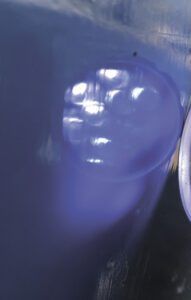An entire category of cleaning agents has sprung up to deal with waterline stains, so we’re always curious about new products (see “Practical Sailor Tests 22 Hull Cleaners on Scummy, Brown Waterline Stains to Find the Best Remedy to the ICW Mustache,” PS February 2010).
Boat Goat claims to be waterline and “ICW-mustache” cleaner, but we weren’t impressed when we tried it on Chesapeake Bay waterline stains. Acid cleaners like oxalic acid, Mary Kate On-and-off, hydrochloric acid, and CLR were all more effective on these stains. Maybe Boat Goat works best on stains from other bodies of water.

Boat Goat smells of butyl (ethylene glycol monobutyl ether), a common ingredient in heavy-duty degreasers (see “The Search is on for the Best Degreaser for Marine Grit and Grime,” PS February 2010). On a whim, we sprayed Boat Goat on a greasy engine. We let it sit for 15 minutes, hosed the engine off, and admired the shine. Next, we tried it on a grimy locker for our portable fuel tank. After rinsing and a few quick swipes with a brush and ordinary boat soap, the locker was white again.
Bottom line: Though not a general purpose cleaner, this is one of the best degreasers we’ve tried, for engines, fuel systems, and bilges.
CLEARCOAT FOR GELCOAT
Our quest for a shortcut to shine inevitably leads us to fiberglass restorers like Poli-Glow and New Glass 2, which we’ve tested along with several other products (see “Hull Restorer Test,” PS May 2007). Typically these restorers are acrylic or acrylic-urethane resins applied in two or three thin coats.
Made in the U.S. by Indiana-based KBS Coatings, Diamond Finish Clear is a tough moisture-cured, single-part polyurethane. It is advertised for coating everything from from car parts to fishing lures to boats.
The maker describes its durability, flexibility, and corrosion resistance as ideal for marine and industrial applications. After proper prep to remove oxidation (compounding or wet-sanding, if needed), you apply at least three thin coats (2 mils each).

Preparation is key. To remove oils and oxidation, the maker prescribes cleaning with its KBS Clean. Next scuff the surface (600 to 1200 grit) and clean again with KBS Klean. Diamond Coat can be sprayed for best results, but it can also be rolled on using a thin-nap roller. You can recoat once the previous coat is dry-to-touch, about 2-4 hours depending on temperature and humidity. KBS suggests a low-nap mohair roller cover. We also had good results with a Glasskoter Slicker, 1/8” nap phenolic foam roller.
For best results, always apply coats consecutively within 8 hours of each coat curing. The trick is not to overwork the roller as this can accelerate curing, and leave marks.
We used the Diamond Finish on a blue 1972 O’Day Javelin, which was cleaned and prepared as directed. We applied by roller outdoors in 78 degrees with 74 percent humidity. The trick is to apply as thin a coat as possible and avoid runs. Our mistake was applying the first coat on lawn-mowing day, which blew dust into coating while it was tacky. We were able to buff out these imperfections. KBS also sells a remover.
Bottom line: If you’ve got an old boat that has lost its shine and you don’t want to bother with the wax routine (or are trying to sell it), the KBS Diamond Finish coating is worth investigating. The coating contains solvents (xylene and naptha) that call for careful handling and personal protection equipment, so be sure to read the safety data sheet. Always test on a small area of the hull first.








































